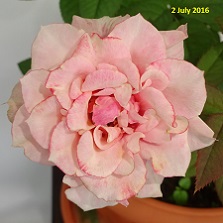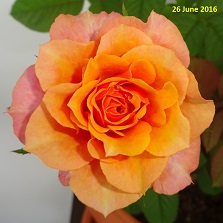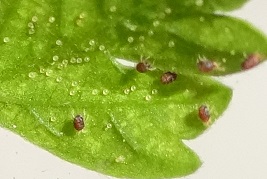| Home | Nature Weekly Index |
3 July 2016 | Rose Plant Blooming |

 This is a follow up note on the progress of the pot of rose plant that I
shared 2 weeks back. After going through the traumatic drying up of at least
50% of the leaves and decease of the all 7 yet-to-bloom flowers, its subsequent recovery was equally dramatic. The first
flower reached full bloom on 26 June with a diameter of about 7 centimetres (cm) and a flower stalk of up to 8 cm. Except
for the external layer of the petals which were red, the rest of them were mainly orange in colour. A half-opened flower
was emitting a nice fragrance. As the flower aged, it became light pink or peach colour. The 2 rose pictures showed the
changed in colour of the same rose over a week. Currently, there were a total of 5 flower in different stages.
This is a follow up note on the progress of the pot of rose plant that I
shared 2 weeks back. After going through the traumatic drying up of at least
50% of the leaves and decease of the all 7 yet-to-bloom flowers, its subsequent recovery was equally dramatic. The first
flower reached full bloom on 26 June with a diameter of about 7 centimetres (cm) and a flower stalk of up to 8 cm. Except
for the external layer of the petals which were red, the rest of them were mainly orange in colour. A half-opened flower
was emitting a nice fragrance. As the flower aged, it became light pink or peach colour. The 2 rose pictures showed the
changed in colour of the same rose over a week. Currently, there were a total of 5 flower in different stages.
 I tried to trace the identity of my potted rose plant which led me to a variety of cultivars but no certainty of the name
of my plant. Being a lovely flowering plant with large colourful blooms, the rose plant has a
long history. It appears that the parent of most
modern day cultivars is
Rosa chinensis
(synonym: Rosa indica) that originated in China. India also
had a long history with the roses
although no one seemed to know when it first get started.
I tried to trace the identity of my potted rose plant which led me to a variety of cultivars but no certainty of the name
of my plant. Being a lovely flowering plant with large colourful blooms, the rose plant has a
long history. It appears that the parent of most
modern day cultivars is
Rosa chinensis
(synonym: Rosa indica) that originated in China. India also
had a long history with the roses
although no one seemed to know when it first get started.
One possible candidate is the Edward's Rose (Floribunda Rose), also known as paneer rose. The word "paneer" means rose water. This popular rose cultivar produces salmon-pink flowers with bronzed young foliage and a light fragrance. The fragrance is most intense when the flowers are half opened. Edward's Rose is a hybrid between tea roses with polyantha roses. Both parents are also hybrids.
 Traditionally, roses may be divided into 3 groups, namely wild, old garden, and modern roses. The wilds roses are also
called species roses. They are the parents of the latter 2 groups. Old and modern roses are separated by a specific year
(which is 1867) when they came into existence.
Traditionally, roses may be divided into 3 groups, namely wild, old garden, and modern roses. The wilds roses are also
called species roses. They are the parents of the latter 2 groups. Old and modern roses are separated by a specific year
(which is 1867) when they came into existence.
I am waiting to see whether the plant will continue to produce flowers after existing batch of flowers are gone. This morning, I just found a few spider mites on the underside of the leaves, which was not a good sign. They had started to migrate from the neighbouring pots.